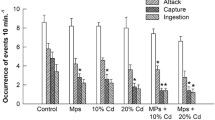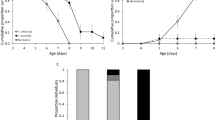Abstract
The sex ratios of two phytoseiid mites, Phytoseiulus persimilis and Amblyseius womersleyi, were observed under various prey conditions. Upon consumption of abundant prey, both phytoseiids produced progeny in a female-biased sex ratio (approximately 0.8 females). When few prey were consumed, the sex ratio was lowered to 0.5 (the unbiased sex ratio). Under the conditions in which the unbiased sex ratio was observed, male and female progeny appeared in an alternating sequence. To determine the change in the sex ratio and the sequence of progeny, the size of eggs deposited by females under various prey conditions was first compared. Survivorship and developmental rate of progeny (immatures) hatched under ample and poor prey conditions were also examined. The eggs deposited under poor prey conditions were smaller than those deposited under ample prey conditions. This is an indication that the phytoseiid females did not invest extra energy into the eggs to secure survival of their progeny under poor prey conditions. The male and female progeny from the small eggs developed slowly, probably due to the small egg size. However, hatchability of the small eggs and survival of the immatures were the same as those of the normal eggs when the immatures were reared under ample prey conditions. The immature survivorship was little affected by the prey consumption rate of their mothers when the immatures were reared under poor prey conditions. We concluded that the sex ratio of phytoseiid mites is not determined by the characteristics of the progeny, but by the nutritious condition of the females.
Exp Appl Acarol 22: 709723 © 1998 Kluwer Academic Publishers
Similar content being viewed by others
REFERENCES
Amano, H. and Chant, D.A. 1978. Some factors affecting reproduction and sex ratio in two species of predacious mites, Phytoseiulus persimilisAthias-Henriot and Amblyseius andersoni(Chant) (Acarina: Phytoseiidae). Can. J. Zool. 56: 1593-1607.
Amano, H. and Chant, D.A. 1986. Laboratory studies on the feeding habits, reproduction and development of three phytoseiid species, Typhlodromus pomi, Phytoseius macropilisand Amblyseius finlandicus(Acari: Phytoseiidae), occurring on abandoned apple trees in Ontario, Canada. Exp. Appl. Acarol. 2: 299-313.
Dinh, N.V., Janssen, A. and Sabelis, M.W. 1988. Reproductive success of Amblyseius idaeusand A. anonymuson a diet of two-spotted spider mites. Exp. Appl. Acarol. 4: 41-51.
Dyer, J. and Swift, F.C. 1979. Sex ratio in field populations of phytoseiid mites (Acarina: Phytoseiidae). Ann. Entomol. Soc. Am. 72: 149-154.
Friese, D.D. and Gilstrap, F.E. 1982. Influence of prey availability on reproduction and prey consumption of Phytoseiulus persimilis, Amblyseius californicusand Metaseiulus occidentalis(Acarina: Phytoseiidae). Int. J. Acarol. 8: 85-89.
Momen, F.M., 1996. Effect of prey density on reproduction, prey consumption and sex-ratio of Amblyseius barkeri(Acari: Phytoseiidae). Acarologia 37: 3-6.
Nagelkerke, C.J. and Sabelis, M.W. 1991. Precise sex-ratio control in the pseudo-arrhenotokous phytoseiid mite Typhlodromus occidentalisNesbitt. In The Acari. Reproduction, development and life-history strategies. R. Schuster and P.W. Murphy (eds), pp. 193-207. Chapman & Hall, London.
Sabelis, M.W. 1985. Sex allocation. In World crop pests: spider mites, their biology, natural enemies and control, Vol. 1B, W. Helle and M.W. Sabelis (eds), pp. 83-94. Elsevier, Amsterdam.
Schulten, G.G.M. 1985. Pseudo-arrhenotoky. In World crop pests: spider mites, their biology, natural enemies and control, Vol. 1B, W. Helle and M.W. Sabelis (eds), pp. 67-71. Elsevier, Amsterdam.
Walter, D.E. 1992. Leaf surface structure and the distribution of Phytoseiusmites (Acarina: Phytoseiidae) in south-eastern Australian forests. Aust. J. Zool. 40: 593-603.
Author information
Authors and Affiliations
Rights and permissions
About this article
Cite this article
Toyoshima, S., Amano, H. Effect of prey density on sex ratio of two predacious mites, Phytoseiulus persimilis and Amblyseius womersleyi (Acari: Phytoseiidae). Exp Appl Acarol 22, 709–723 (1998). https://doi.org/10.1023/A:1006093424452
Issue Date:
DOI: https://doi.org/10.1023/A:1006093424452




